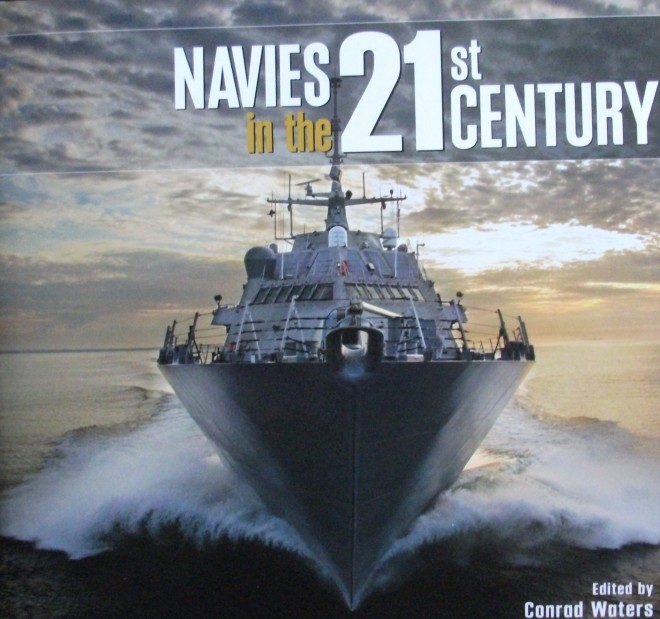
Reviewer: Michael Keith
Title: British Destroyer’s & Frigates: The Second World War And After
Author: Norman Friedman
Total Number of Pages: 352
Rating Scale (1: Very Poor, 10: Excellent: 7
_____________________________
Naval vessel-types have a very distinct hierarchy. At the top are the aircraft carriers (the Queen Bees; if you will); at the bottom, the Worker Bees; the destroyers and the frigates; the vessels that (at least in the opinions of their crews) do the actual work. This is their story; specifically, it is the story of the development and evolution of the destroyers and frigates used by both the Royal Navy and the Commonwealth navies it is affiliated to.
The story is a complex one and in the course of its narrative the reader is introduced to the multitudinous issues which effect and contribute-towards warship design. The numerous non-naval influences which must also be considered (especially in regards to ‘matters political’), are also discussed.
Although the Contents list indicates the Introduction is the first section to appear after it, a single-page List Of Abbreviations holds that honour. There is however no reference to its existence on the Contents page. That detail notwithstanding, the Introduction provides a multi-page summation of the material that appears within the Chapters which follow. A single-column Acknowledgements subsection placed within this section thanks those who assisted with the volume’s creation. The Introduction is followed by the 15 Chapters which comprise the bulk of the volume. The Chapters narrate the development of the two vessel- types over the 1939-2006 period covered by this volume. It should be noted however that, for purposes of continuity, the volume’s narrative actually commences before World War II. Within the individual Chapter, each page consists of two columns of print. Footnotes are used within each Chapter to provide additional information. These are numbered consecutively within each Chapter, with the citations (where used) appearing at the foot of each column. Where necessary, subsections within an individual Chapter provide additional elaboration on a specific part of the larger narrative within that particular chapter. Their existence is not however acknowledged on the Contents page. A single-page Bibliography follows the final Chapter and is itself followed by an eight-page section titled Data Tables. This section contains specifications for the vessels referred to within the volume. The information is presented in columnar and tabulated form. Relevant notes appear at the end of each individual section. These are not however in Footnote format but rather occupy the width of the individual section. Abbreviations are used throughout the section. Of these, a small number also appear on the previously-mentioned List Of Abbreviations (in one instance [DCT] with a different meaning). The majority are however, section-specific, and their meanings are listed in a column appearing at the head of the section, A List of Ships section follows. This provides construction and paying-off details (or, if not relevant, the vessel’s fate) of every destroyer or frigate constructed by British dockyards from 1936 onwards. It also uses abbreviations (albeit in a smaller quantity) and these are placed at the front of the section. An Index completes the volume. This book contains numerous descriptively-captioned monochrome Photographs from a variety of sources, together with plans and profile drawings of individual vessels. Tables are used for comparative purposes where required. Concept paintings have been utilised where relevant to the narrative while photographs of armaments and electronic antennae are included where necessary. There is no reference to the existence of any of these (photographs, tables etc.) on the Contents page, although the Index does state that ‘Page references in Italics refer to illustration captions’..
The volume is well-written, researched and eminently readable. It is likely to appeal a variety of readers and may well become a standard reference work on its subject. The potential readership could include both naval personnel, and those with a general interest in the Royal Navy.. Those with a more general interest in naval and maritime matters are also likely to find this volume of interest. ‘The many photographs and drawings are likely to be invaluable to both ship modellers and to marine artists with an interest in British naval vessels.
In this regard, and because of the likelihood of ‘high use’ by its purchasers, this reviewer did wonder if the volume should perhaps have been printed in a ‘hard cover’ format; if only to prolong its cover life.
For this reviewer, this volume is let down by the ‘small details. The result is a ‘Good’ book; it could have been a ‘Great’ book.
On a Rating Scale (1: Very Poor, 10: Excellent, I have given it a 7.
__________________________________________________

